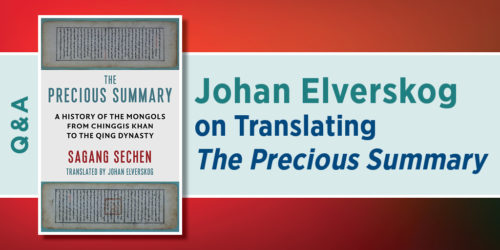Alejandra C. Quintana Arocho on Translating Gabriela Mistral’s Desolación

Gabriela Mistral, born Lucila Godoy Alcayaga in Vicuña, Chile, has fascinated and puzzled scholars, writers, and artists alike for more than a century. Many have tried to weave together the variegated layers of her persona and her “emotionally outspoken verses,” as Langston Hughes describes them. There is extensive scholarship on her life, her work, and her connections to her contemporaries, but much of this is drawn from or reproduces a particular, composite image of Mistral: that of the Nobel Prize winner, the national symbol of Chile, the devout Christian heterosexual woman par excellence, and the caring yet solitary rural teacher.
The dominant position among critics has been to selectively analyze Mistral’s work, eliding aspects of her poetry and personhood that might destabilize normative ideas about gender, sexuality, and the Chilean nation. In decentering Mistral’s queerness and relegating it to the margins of scholarship on her life and work, government agencies and cultural centers across and beyond Latin America have found ingenious ways to uphold and preserve a conservative image of Mistral.
Federico de Onís, founding director of Columbia University’s Hispanic Institute, corresponded with Mistral in 1921–1922 to express interest in publishing a volume of her collected poetry. Mistral shared with de Onís practically all of the poems she had written up to that point, which he edited as her first published book, Desolación (1922). In letters and in the preface to this collection, de Onís framed Mistral as an “unknown” poet whom he had discovered for the benefit of “North American teachers”—a poet whose work he perceived to be not just of “great literary value” but of “superior moral stature” as well.
This approach cast her poetry as meritorious for its affective power rather than its lyrical mastery.
Elizabeth Horan, writing on the success of Desolación in her book Gabriela Mistral: An Artist and Her People (1994), recognizes this active framing of Mistral on the part of de Onís as a means to sell the idea, early on, that Mistral’s writing has a “moving” quality. This approach cast her poetry as meritorious for its affective power rather than its lyrical mastery. Critics, in fact, have been quick to group Mistral with Alfonsina Storni and Delmira Agustini as writers of the “sentimental experience,” as “lovers of nature” who offer lessons on life, death, and suffering—which they certainly were—yet the works of Storni and Agustini were not always tinged with the moralist tone often projected onto Mistral.
Since Mistral was canonized prematurely through this framing of “moral” teacher and woman, the achievements and alliances that Mistral had already attained in her country and abroad—as well as her initial stylistic innovations—have been largely ignored. In this recent translation, we sought to invest her language with the same “emotional power” it holds in Spanish, while highlighting the more radical (and, until now, critically unexamined) use of poetic language and devices that have to do with the female gaze and sensorial experience.
Mistral’s gaze, or that of her poetic speaker, is attentive and restless, and it unabashedly lingers in the contours of the faces and bodies of women while also welcoming the gaze(s) of others, nature, or anything that may look back at her. The act of looking in her poems is one of radical sensitivity; the lines in her poems extend to make room for keen observation while recognizing that the gaze is not one-sided. Mistral teaches you how to look, and she has no qualms in honing in on whatever catches her eye, which perhaps makes her gaze somewhat odd to the untrained one.
Mistral teaches you how to look, and she has no qualms in honing in on whatever catches her eye, which perhaps makes her gaze somewhat odd to the untrained one.
We focused on how Mistral uses the gaze to explore themes often relegated to the periphery of discussions on woman- and motherhood, like desire, self-perception, and changes in the body. The recurring objects and subjects of the poetic speaker’s gaze—strong, barren, and everyday women; breasts, flesh, and swollen hips; bodily wonder and decay—are all brought to the forefront in this translation.
In paying attention to how gender and sexuality operate in the text, Inés Bellina, Anne Freeland, and I made sure to employ gender-neutral language or to alternate between masculine and feminine pronouns, in cases where the use of the masculine neuter in Spanish was not deliberately or explicitly gendered. For example, in the poem “The Guardian Angel,” there is scarcely a reference to the angel’s gender, and though Mistral resorts to using masculine pronouns, it seems to be more of an effort to be grammatically correct (because the word angel is masculine in Spanish) and less so to portray a masculine figure. Our approach, then, was to replace the masculine pronouns with feminine ones, destabilizing the use of the masculine neuter while still casting the angel as a potentially gender-neutral figure. Where the word hijo appeared in the text, we also resorted to the gender-neutral “child” and/or used third-person, feminine, and masculine pronouns interchangeably to preserve Mistral’s not necessarily gendered, perhaps intentionally ungendered verse.
In a note at the end of her “Poemas de las madres,” Mistral describes this section and the rest of the poetry in the collection as “selfish work.” She says so in the context of women who had complained that her poems for mothers were too concerned with the “cruel” realities of being a mother, with anything that did not have to do with the worries of “chaste” women. They, like the men Mistral writes about at the end of the book in her “Vow,” seem to suggest that it was too uncomfortable for them to read, that it was too “bitter” a book for those to whom “life feels like sweetness.” Yet Mistral does not seek their approval, nor that of de Onís and the other men who offered to publish her work, for that matter. She opted to write about and disseminate the voices of women rarely given the spotlight in the world of “great literary” texts. For this reason, I hope our translation of Desolación remains Mistral’s own “selfish work,” giving it back to her to make her lyrical complexity and distinct poetic voice even more evident.
By choosing to translate the first volume of her poetry the way she herself might have preferred, embracing and not discarding traces of her persona, we aim to provide new avenues for the study of the not-so-elusive Mistral in the twenty-first century. I hope that Inés, Anne, and I have produced a translation that renders Gabriela Mistral’s poetry accessible yet not too simplified, both innovative and traditional, both urban and rural, and, above all, queer and unforgettable.
Alejandra C. Quintana Arocho holds a BA in Comparative Literature and Society from Columbia University. She is co-translator of Desolación: centennial edition.








